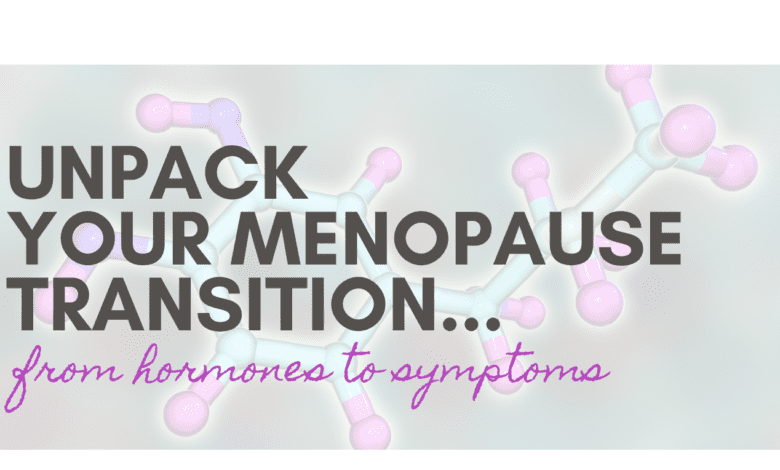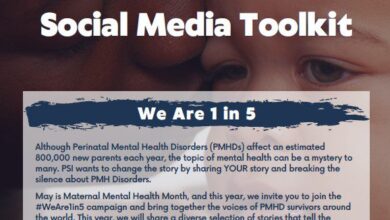The Signs & Science of the Menopause Transition

A few days ago, I shared the first email in a series about my bumpy road as I navigated the menopause transition and how I’m on a mission to bring more awareness to this transition and provide strategies to help you
In this email I am pulling back the curtain on the signs and the science behind the perimenopause transition.
Read if this applies to you or someone you love…
First, the SCIENCE of Menopause:
This may surprise you…
MENOPAUSE is defined as just ONE moment in time: the moment when you’ve been period-free for an entire year.
But all the hormonal fluctuations that cause the symptoms we associate with menopause begin years—sometimes years—before that moment.
51 or 52 is the national average age of menopause.
PERIMENOPAUSE is the menopause transition where you go from your regular cycle of 25 to 40 days, lasting three to seven days, to a very inconsistent cycle.
You may miss a period or have heavy, prolonged periods that seem to go on forever. 😭
(This happens in your menstrual cycle because the sex hormones that orchestrate the rhythms of your cycle since you hit puberty change. We’ll talk about hormones in a moment…)
Perimenopause can begin at age 36 but usually begins at age 45.
Hormonal fluctuations can last up to 10 years, but they are generally more noticeable for four to five years BEFORE your periods stop for good.
POSTMENOPAUSE includes everything AFTER a certain point in time when you have gone a full year without a period and until the end of life, but transition symptoms can last a decade or more into postmenopause for some women.
It was also a unique experience.
No two people will experience it the same way. And there is no one magic solution for menopause symptoms that will work for everyone.
⛔ But that doesn’t mean it’s completely out of your control.
While menopause may not be perfect or easy…
… various lifestyle factors can significantly influence the nature of the experience.
(You’ll learn three simple strategies you can implement right away to contribute to a better perimenopause experience in the next email.)
The STRUGGLES of Menopause
Let’s talk about perimenopause hormonal SOS.
This is the time—during the perimenopause transition—when you notice things aren’t what they used to be.
Some of my clients have noticed that their eating and exercise habits that worked well in the past are no longer delivering the same results.
Things we used to get rid of (like a weekend of binge eating) can now leave us feeling lousy for days. “Tricks” we may have used in the past to lose weight (like detoxes or crash diet) are no longer delivered. In fact, they can be flat. -out backfire.
This is when you start to feel the natural changes that people refer to as “menopause”: you start to have night sweats, put on belly fat, lose lean mass, and no longer feel strong or capable. as usual.
 Why?…
Why?…
HORMONES and Menopause
All of this happens because your hormone ratios have changed and your body is responding to that change.
Your hormones are messengers that tell your body what it needs to do to stay healthy and strong. They’re said to grow your muscles and build your bones, and they help regulate your temperature, appetite and fat storage.
As we enter our menopausal years, those hormones start to go a little haywire.
Some messengers disappear, while others hang around. Some functions are eliminated, while other functions only receive some of the messages they come across.
The system is on the fritz, the result can be metabolic disturbances.
Symptoms that make you feel like you’re turning into an oven in the middle of the night, MIA mojo, and changing body composition are really your hormones are sending out a distress call—an SOS signal for you to give them help because they can no longer perform their functions as before.
The good news…
… you can respond to these signals by stepping in and taking action to minimize the effects of hormonal fluctuations.
Taking action during perimenopause can have a profound effect! #gamechanger
Too many women write off what they’re going through as “just getting older”. 🙄
Some of the changes may be age-related but many of them, such as pronounced changes in body composition, poor insulin sensitivity, hot flashes, mood swings, disrupted sleep, and poor energy levels are hormonally driven and can be reduced.

This is where lifestyle changes can help improve your perimenopause transition (more on that to come in the next email).
So. many. SYMPTOMS of Menopause.
You have hormone receptors in EVERY ORGAN in your body, so when your hormones start to fluctuate and ebb and flow, every part of your body is affected. We hear a lot about certain symptoms but there are MANY common symptoms associated with the menopause transition.
Here is a fairly comprehensive list of what you may experience in this lifetime. We can’t cure every symptom, but we can certainly improve it with lifestyle changes.

I realize this is a lot of information to digest, some of it may be new to you (most of it is to me!).
I just couldn’t figure out WHY I was feeling and experiencing some of these symptoms. I did chalk it up to being older. But as I began to unpack the science behind the “why”, it all made sense.
The good news is, there are things you can do proactively to support your journey and reduce the severity of your symptoms, or get ahead of the curve and start implementing better healthy habits today.
In the next few emails, you will learn three simple strategies on how to deal with body composition changes and how I can support your journey.
For now, drop me an email (Cassandra@ActiveMomsClub.com) and tell me → what is your biggest concern or struggle as it relates to your menopause transition?
Xoxo, Coach C~
PS If you are not yet in the menopause transition, and you know someone who is, share this blog post with them. We all need to be informed to be our own greatest champions.





